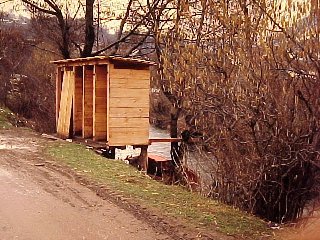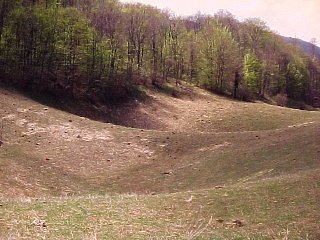Physical Geology Slides-Ground Water
Steven Dutch, Professor Emeritus, Natural and Applied Sciences, University of Wisconsin - Green Bay
Water For Human Use
 |
California doesn't have a water shortage; it has a people overage. The rainfall in this environment is perfectly sufficient to support the savanna ecosystem seen here. It's just not sufficient to support ecosystems like Los Angeles and San Francisco. The reservoir here is part of California's water supply system, severely depleted by a succession of dry years. |
 |
Los Angeles recognized early in the 1900's that water was what limited its growth, so the city purchased the water rights in most of the Owens Valley, east of the Sierra Nevada. This shows the aqueduct that carries water from the valley to Los Angeles. |
 |
Los Angeles water usage lowered the water level in Mono Lake by over 40 feet before a court order forced the city to limit withdrawals. |
 |
This aqueduct in the San Bernardino Mountains is part of the water system supplying southern California. The Stop sign approximately marks the San Andreas Fault. |
 |
In the 1920's and 1930's, San Francisco dammed the Hetch Hetchy Valley, the next major canyon north of Yosemite Valley. This is a distant view of the dam. It's surprisingly inconspicuous, but that's the point of a dam - impound the most water using the least materials. |
 |
California conservationists considered the damming of the valley a bitter blow, but it's hard to look at the lake and see an environmental catastrophe. There is no fishing, swimming or boating on the lake (the boat belongs to the water authority). |
 |
These circles in Nebraska are due to a revolutionary development in farming called center-pivot irrigation. Center-pivot irrigation has made it possible to farm land that otherwise could not be farmed, but has also dramatically increased the pressure on aquifers. |
 |
A center pivot rig. Each set of wheels is independently driven. Linkages between wheels turn the motors on and off and keep the overall rig straight. In Wisconsin a center-pivot rig means the difference between a poor crop and a good one. In the High Plains it means the difference between farming and not farming. |
 |
Some places have more water than they need. New Orleans is kept low and dry by a massive pumping operation. This boom is returning water to the Mississippi. |
 |
New Orleans is famous for its above-ground cemeteries, partly a matter of European fashion but also due to the high water table that can cause coffins to float upward. This is not exactly what they had in mind by "the South will rise again!" |
 |
This is your intestinal tract. This is your intestinal tract with cholera. Any questions? A scene from Bosnia, illustrating why clean water is such a problem even now for so much of the world's population. Women in some Third World countries spend a third of their time just gathering water. |
Karst
 |
This gypsum block at Knossos in Crete has been severely etched by solution, probably in only the century or so since the site was excavated. |
 |
A karst landscape in Turkey. Below the valley, a limestone layer is dotted by hundreds of sinkholes. The limestone has been eroded away above the valley. |
 |
In areas with a lot of water, karst looks like this. There are innumerable flooded sinkholes. This example is in Argentina but large areas of Florida look similar. |
 |
The word "karst" comes from Serbo-Croatian, and the archetypical karst landscapes are in the former Yugoslavia. In this valley in Bosnia, several sinkholes have merged to create a larger depression called a solution valley. |
Wisconsin Karst
 |
Karst in Wisconsin tends to be subtle. The glaciers buried or carried off much of it, and dolomite is not as soluble as limestone. This small sinkhole is at High Cliff State Park. The surrounding dolomite sags smoothly into the sinkhole. |
 |
In September, 1992, seven inches of rain fell in a day in western Wisconsin, and the weight of water caused a small cave beneath this stream to collapse. The students are standing in the now-dry stream bed. |
 |
The water in the stream is now flowing underground. The cave is probably not big enough for a person to crawl through. |
 |
Rockhounds find this phenomenon fascinating. |
 |
Looking down the former stream bed. The water gradually re-enters the stream by seepage a couple of miles down. |
Karst in China
 |
Most people, if they ever gave the matter any thought at all, tend to assume traditional Chinese art like this is artistic license. In fact, this is a realistic depiction of the landscape of part of southern China. |
 |
This is about as perfect a realization of Chinese art in real life as anyone could imagine. |
 |
Guilin has become one of China's top tourist attractions because of its spectacular tower karst landscape. Tower karst forms in tropical regions when thick limestone dissolves rapidly, and occurs throughout southeast Asia. More than one night mission in Vietnam ended by flying into a karst tower. A submerged tower karst on the coast of Thailand was the setting for scenes in the James Bond films Man with the Golden Gun and Tomorrow Never Dies. Less spectacular examples occur in Cuba and Puerto Rico. |
 |
This aerial view shows that the pinnacles actually surround large solution valleys. The pinnacles are columns left behind when sinkholes expand and merge. The pinnacles are riddled with caves and are geologically very ephemeral features. |
Geothermal Phenomena
 |
Geothermal phenomena like Mammoth Hot Springs in Yellowstone National Park typically get their heat from a shallow magma chamber. The terraces form when dissolved minerals (mostly silica) form a rim around a shallow puddle. As the puddle rises, so does the rim. Eventually, the puddle overflows and the flowing mineralized water rounds off the rim of the terrace with new mineral deposition. |
 |
Films often portray Old Faithful going off with a roar. In reality it sounds a lot more like a giant fire hose. Geysers are very transient phenomena. They plug up with mineral deposition or blow themselves apart with violent eruptions. Old Faithful probably didn't exist a few thousand years ago and probably won't exist in a few thousand years more. |
 |
Looking into the Grand Canyon of the Yellowstone, it becomes obvious that the present geothermal phenomena in Yellowstone are the tiniest fraction of what has occurred there. The entire plateau has simmered in boiling water, and the vivid colors of the canyon are all due to hydrothermal alteration of the rocks. |
 |
20 million years ago, the San Juan Mountains of southwestern Colorado were another Yellowstone, a volcanic plateau parboiled in geothermal waters. The orange stain on the mountainside is a zone of hydrothermal alteration and mineralization. The San Juan Mountains were once a rich mining district. 20 million years from now, Yellowstone may look like this. |
Return to Physical Geology Notes Index
Return to Professor Dutch's Home Page
Created 13 July 1998, Last Update 12 January 2001